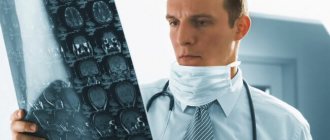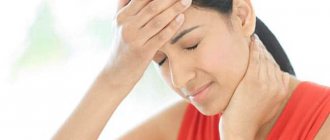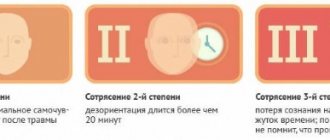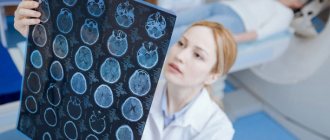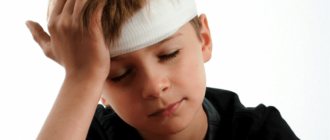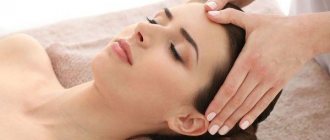What is a mild concussion?
A mild concussion is a pathology in which, during the examination of the patient, no serious disturbances in the functioning of the brain are detected and the integrity of the skull bones is preserved. Causes of injury may be:
- A situation where a person slips on ice and loses his balance.
- A fall.
- Direct blow to the head.
- Road traffic accidents.
- Failure to comply with safety precautions when playing sports.
- Bad landing.
Athletes (boxers, karatekas, kickboxers, football players) often face a similar problem. In more than half of cases, injury occurs at home. The development of this pathology is based on the following disorders:
- separation of brain structures;
- change in the colloidal state of tissues;
- disruption of communication between nerve cells;
- narrowing of blood vessels;
- deterioration of brain oxygenation.
First aid to the victim - what to do?
A concussion threatens to rupture blood vessels and develop a hematoma. The consequence may even be paralysis. Before the ambulance arrives, a heating pad with cold water or a wet towel should be placed on the victim’s forehead, after placing the person on the sofa and placing a pillow under his head.
If the patient is nauseous, turn him on his side. Measure blood pressure and temperature, ask in detail about what happened - doctors need all the information.
Important! It is necessary to ensure that the victim does not fall asleep, this sometimes leads to coma after this type of injury. You should talk to the patient all the time, ask him about something.
Symptoms of a mild concussion
Signs of a mild concussion include:
- Sensation of pulsation in the head.
- Noise in ears. Patients feel hissing, ringing or humming. The causes of this symptom are compression of the auditory nerve and irritation of the receptors.
- State of stupefaction. The reason is a disruption in the conduction of nerve impulses at the time of injury.
- Tension of facial muscles.
- Decreased response to external stimuli.
- Dizziness. Often, with this injury, patients cannot stand on their feet and take a forced position (sitting with support or lying down). Dizziness becomes worse when changing body position.
- Discomfort in the eye area. Appears while reading books, watching TV and when retracting the eyeballs.
- Loss of coordination.
- Sweating. The palms of patients may be covered with cold and sticky sweat. It often appears on the forehead.
- Nausea. Appears as a result of stimulation of the vomiting center.
- One-time vomiting. Not always observed.
- Increased breathing. The respiratory rate after injury exceeds 16 per minute.
- Change in heart rate. It can either speed up or slow down.
- Headache. Most often it does not have a clear localization, diffuse, pressing or squeezing. The reason is increased pressure inside the skull.
- Loss of appetite.
- General malaise.
- Weakness.
- Visual disturbances in the form of mydriasis (dilation of the pupils) or miosis (constriction of the pupils) and eye tremors. Victims have difficulty seeing objects and items clearly immediately after injury.
- Changes in tendon reflexes.
With this form of brain damage, long-term symptoms may occur that appear within a few days. These include sleep disturbances, irritability, anxiety, fear of bright lights, memory impairment, impaired concentration, noise hypersensitivity and depression.
Degrees
There are 3 main degrees of concussion.
In case of a head injury or if a mild concussion is suspected, all possible symptoms should be compared. The stages of a mild concussion can be characterized as follows:
- In the first degree, mild fainting occurs, the condition returns to normal within 20-30 minutes.
- With the second degree of concussion, disorientation in space occurs for some time.
- With grade 3, loss of consciousness is observed for a short period. Usually the victim does not remember what happened to him.
Characteristic signs may not appear immediately, but after a day or quite a long time, perhaps even a week.
If there is any manifestation of a concussion, the victim should be examined by a doctor. An inexperienced person may mistake a concussion for a bruise, and this can worsen the situation. Even the slightest injury can cause a hematoma to develop.
What to do if you have a mild concussion?
If a person has a mild concussion, then it is necessary to consult a doctor to clarify the diagnosis.
This will require a neurological and physical examination, fundus examination, interview, MRI or CT scan, electroencephalography and radiography. The absence of hematomas, hemorrhages, skull fractures, the normal composition of the cerebrospinal fluid and a typical clinical picture indicate a concussion. First aid for a concussion includes:
- calling an ambulance or going to the nearest emergency room;
- ensuring complete physical peace and quiet;
- giving a comfortable position (the patient is placed on the bed on the right side, legs and arms are bent and a pillow is placed under the head);
- ensuring a flow of clean air;
- removing restrictive clothing (corset, tie);
- constant monitoring of vital signs (pressure, pulse and respiratory rate).
Diagnostics and examination
Only a doctor can give an accurate answer on what to do in case of a concussion after a thorough examination of the patient, a detailed interview and a diagnostic examination. Even if minor deviations from the norm are recorded in a person’s condition after a head injury, a medical examination is mandatory, this will help to avoid complications.
The doctor conducts a survey using the Glasgow scale. The patient is tested and a score is assigned according to his condition. If the specialist counts 13-15 points, the patient is diagnosed with a concussion.
Additional research:
- EEG – to determine the biological activity of certain parts of the brain.
- To determine whether intracranial pressure has increased, an examination of the fundus is performed.
- Ultrasound of cerebral vessels, carotid artery, and blood vessels of the neck.
- X-ray of the head, cervical spine.
- CT scan.
- MRI of the brain.
Since some symptoms of a concussion may appear in a patient 12-15 hours after a head injury, the patient should be in the hospital for the first 24 hours after the incident. If it worsens, treatment may take several days.
Treatment
Brain therapy at home is carried out after the main symptoms have been eliminated and the condition has normalized. Patients can be treated on an outpatient basis, but after excluding more serious pathologies (brain contusion, diffuse axonal damage). Treatment involves:
- Improving brain function and metabolic processes.
- Relieving pain and eliminating dizziness.
- Normalization of sleep.
- Massage.
Medicines
The following medications may be used for a concussion:
- Nootropics and drugs that improve brain activity. Cavinton, Pantogam, Cinnarizine, Sermion and Piracetam are often prescribed. These drugs are most often used 5-7 days after the injury.
- Painkillers. Analgin and Baralgin are effective for headaches. Sedalgin Plus helps a lot. The most commonly prescribed painkillers are in tablet form.
- Drugs that relieve dizziness. These include Betaserc, Betagistine, Tagista, Vestibo, Cavinton and Vinpocetine.
- Medicines that normalize sleep. This group includes Reladorm and Phenobarbital.
- Antioxidants (Mexidol, Mildronate, Mexiprim and Meldonium). These drugs help you cope with anxiety and improve metabolic processes in the brain.
- Anti-anxiety medications and antidepressants.
Patients are often prescribed multivitamins, tincture of Eleutherococcus and Schisandra. They increase the overall tone of the body. Drugs are prescribed taking into account the patient’s age, individual tolerance and contraindications.
Folk remedies
Treatment at home may include the use of traditional medicine. The most commonly used:
- Means that reduce the excitability of the nervous system. These include an infusion based on thyme, mint and motherwort. The resulting mixture should be poured with boiling water, strained and taken 100 ml for 10 days.
- An infusion of valerian root, St. John's wort, birch leaves, fireweed, hops and buckthorn bark.
- Honey.
- A mixture based on elecampane and myrtle.
- Crushed ginkgo biloba leaves.
- Walnuts.
- A mixture based on honey, hawthorn and sea buckthorn.
- Mint tincture with cinnamon.
- Tincture based on anise fruit.
- Juice from raw potatoes.
- Cabbage juice.
- Raspberry decoction with white willow.
After a concussion, it is useful to eat foods rich in vitamins. These include greens (onions, lettuce, spinach), fruits, vegetables, berries and natural juices.
Drugs
The main medications for mild concussion in adults are the following:
- "Cinnarizine";
- "Piracetam";
- "Pyriditol";
- "Instenon";
- "Nicotinate";
- "Xanthinol";
- amino acids.
What medications are prescribed for children for mild concussions? Here are some of them:
- "Diacarb";
- "Furosemide";
- "Panangin";
- "Piracetam";
- "Phenozepam" (for sedative purposes);
- “Sedalgin”, “Baralgin” (painkillers);
- "Cerucal" (elimination of nausea);
- vitamins.
Painkiller:
- "Analgin";
- "Pentalgin";
- "Sedalgin";
- "Ketorolac".
To restore the nervous system and support the nutrition of brain cells:
- "Glycine";
- "Piracetam";
- "Nootropil";
- "Pantogan."
To strengthen blood vessels and normalize metabolism:
- "Vasotropin";
- "Cavinton";
- "Teonikol".
To reduce swelling and intracranial pressure:
- Potassium preparations;
- "Diacarb";
- "Furosemide";
- "Arifon".
To eliminate dizziness and nausea:
- "Tanakan";
- "Platifillin";
- "Papaverine".
Helps cope with insomnia and relieve tension:
- valerian;
- "Corvalol";
- motherwort.
Tranquilizers:
- "Adaptol";
- "Phenazepam";
- "Elenium";
- "Nozepam."
You should also take B vitamins.
Consequences
Serious complications are rare with this brain injury. Sometimes the following consequences are possible:
- Epilepsy.
- Inflammation of the substance and membranes of the brain. A rare complication of a concussion.
- Post-concussion syndrome. It includes confusion, memory loss, headache and other symptoms.
- Violation of the vestibular apparatus.
- Increased sensitivity to light and sounds.
- Decreased ability to work due to asthenia.
The risk of complications is higher in people with concomitant neurological and vascular diseases, as well as in cases of repeated concussions.
Possible complications
If you don’t follow your doctor’s recommendations: don’t follow a diet or regimen, increase exercise too early or intensely - this can lead to long-term consequences. Such patients then regularly visit the neurologist's office.
Often they cannot restore their previous health and work skills. It is difficult for them to master the work; at the slightest overexertion they develop headaches and irritation. Their emotional background is unstable, they are difficult to get along with people.
Therefore, you need to take on the load little by little, in accordance with the forces available at the moment. Once you begin your work duties, you must adhere to the work and rest schedule prescribed by your doctor. This will give a stable and complete recovery.
A concussion is an insidious injury; symptoms may appear only after a few days, but the consequences can haunt a person for the rest of his life.
Proper treatment for a concussion will help avoid complications. If the patient does not follow the doctor's recommendations and refuses to adhere to bed rest after a concussion, his condition may worsen. In addition, negative consequences appear after some time:
- Headaches and dizziness appear.
- Traumatic encephalopathy develops.
- Memory deteriorates.
- Meteor dependence develops.
- Irritability and sudden mood swings appear.
- The development of depressive states, neuroses, and the appearance of phobias is possible.
- Insomnia is noted.
Sometimes a concussion can lead to serious complications: the development of syncope, epilepsy, tonic-clonic seizures, and dementia. To avoid this, the patient needs to be observed by a neurologist for a year, periodically undergo examinations, and have electroencephalography done.
Recommendations
What to do if you have a mild concussion during rehabilitation?
The main recommendation is to follow a daily routine. In order to improve your health as quickly as possible, you must remain in bed for at least 5 days. You should take sick leave for 12-14 days to fully return to normal.
Many people are interested in whether it is possible to walk with a mild concussion? At first, of course, it is undesirable, and it is best to do this in the presence of loved ones, so as to always be visible. Movement should be minimal, only to satisfy important needs.
You can listen to music, but not with headphones. Also, at first, you should avoid entertainment that has a strong impact on the eyes. It is worth excluding mobile phones, video games and watching TV.
During this period, it is strongly recommended not to be exposed to emotional stress. You should not worry, be nervous, participate in long conversations, or enter into conflicts.
The room should have dim lighting and closed windows if sunlight interferes.
If you follow all the recommendations, your health will begin to improve within 2-3 days. Even if the victim returned to normal condition after a short time, he needs to lie in bed for at least 5-7 days.
